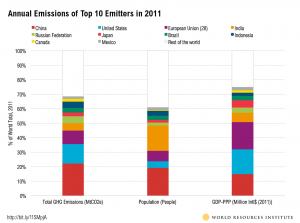“Continued participation in the Paris Agreement would be fundamentally unfair to American taxpayers. It would require the transfer of billions of their hard-earned dollars to other countries through the ‘Green Climate Fund.’”
Truth-O-Meter rating: mostly false (contains an element of truth but ignores critical facts that would give a different impression).
This statement comes from a letter written by President Trump regarding the United States’ recent withdrawal from the Paris Agreement, which the Obama Administration signed in April 2016. Finance alone can generate fear, frustration, and confusion, but finance and climate change can sound even scarier without context.
Climate finance refers to the way that the world manages and raises money to pay for climate change action which includes both mitigation (reducing the impacts) and adaptation (adjusting to new conditions). Since 1994, under the UNFCCC, developed countries have had an obligation to contribute financial resources to developing country parties to fund climate change action. The Paris Agreement calls on developed country members to generate both mitigation and adaptation funds to assist developing country parties in the transition to sustainable development. The Green Climate Fund (GCF) is one of the two managers of global climate finance under the UNFCCC with the task of investing in, as opposed to transferring (as suggested by President Trump), adaptation and mitigation projects in developing countries (“Climate Get the Big Picture”). The GCF has a Readiness and Preparatory Support Programme to help empower developing countries participating and receiving contributions from the fund. This program helps ensure the alignment of national priorities for climate change action with the planning processes for new investments.
Developed countries collectively agreed to the goal of contributing 100 billion USD per year by 2020. Currently, the GCF has raised 10.3 billion USD in pledges from 43 governments worldwide. As of August 18, 2017, the United States has contributed (announced, signed, and disbursed) 3 billion USD to the GCF. While President Trump’s claim that the U.S. contributes billions of dollars to other countries under the Paris Agreement is true, his assertion that this contribution is “unfair to American taxpayers” is false. Even though the U.S. has the largest total pledged contribution in the GCF, the total pledged contribution amount per person is only 9.41 USD. In comparison to several other developed nations like Germany (12.13 USD per person) and France (16.03 USD per person), the U.S. has a relatively smaller commitment based on the enormous size of the U.S. economy compared to other developed and developing countries’ economies (“Resource Mobilization”).
Moreover, the U.S. is the world’s second largest greenhouse gas (GHG) emitter followed by the European Union (which counts the total emissions of 28 member states) (Ge, Mengpin, et al.). Based on the United States’ historically huge global carbon footprint and the country’s ability to finance climate change action relative to other countries, participation in the Paris Climate Agreement is fair despite American taxpayers’ unwillingness to accept this global responsibility (Ge, Mengpin, et al).

Figure A. Annual Emissions of Top 10 Emitters in 2011. This bar graph demonstrates that compared to other top emitters, the U.S. is one of the most economically developed countries in the world and has the second highest total GHG emissions. The population bar shows that the population of the U.S. is smaller than China and India, and closer in size to Brazil or Indonesia. Americans are responsible for more than their fair share of the total global GHG emissions, so the developing world expects them to lead in helping the most vulnerable nations to deal with and mitigate the impacts of climate change.
Works Cited
“Climate Get the Big Picture.” UNFCCC. United Nations Framework Convention on Climate Change, bigpicture.unfccc.int. Accessed 29 Aug. 2017.
Ge, Mengpin, et al. “6 Graphs Explain the World’s Top 10 Emitters.” World Resources Institute, 25 Nov. 2014. www.wri.org/blog/2014/11/6-graphs-explain-world%E2%80%99s-top-10-emitters.
“Readiness Support.” Green Climate Fund, www.greenclimate.fund/gcf101/empowering-countries/readiness-support. Accessed 8 Sept. 2017.
“Resource Mobilization.” Green Climate Fund, 2017, www.greenclimate.fund/how-we-work/resource-mobilization.
The White House. U.S. Leadership and the Historic Paris Agreement to Combat Climate Change. Office of the Press Secretary, 2015. Web. 6 Sept. 2017.
